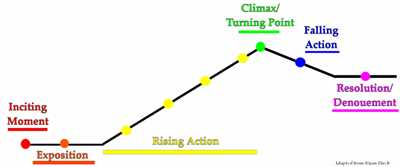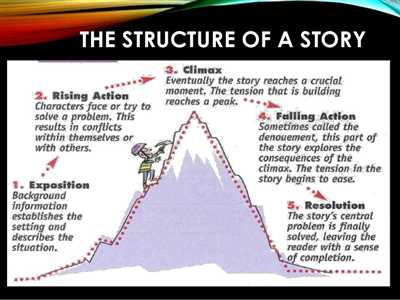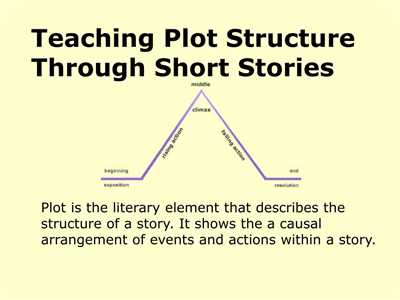
Writing a short story is a process that takes creativity, skill, and a strong understanding of story structure. While there are many ways to structure a story, it is important to develop a unique structure that will captivate readers from the start. In this article, we will explore some tips on how to structure your short story and offer further advice on developing a strong climax, engaging characters, and compelling story development.
When it comes to structuring your short story, one option is to follow a traditional story structure that readers are familiar with. This includes an introduction, rising action, climax, falling action, and resolution. However, for writers looking to break free from the traditional box, there are many other structures to consider. You could begin your story in the middle of the action, in media res, or even start with the climax and then flash back to the events leading up to it. The choice is yours, and experimenting with different structures can make your story stand out.
In addition to experimenting with different structures, it is important to pay attention to the development of your characters. Strong and relatable characters can make or break a short story. Take the time to create well-rounded characters that readers can connect with. Give them flaws, desires, and motivations that drive the plot forward. This will make your story more engaging and believable.
Another tip for structuring your short story is to focus on the development of the plot. Start with a clear idea of what will happen in your story and what the main conflict or challenge will be. As you write, keep the plot moving forward with tension and suspense. This will keep readers hooked and eager to find out what happens next.
While developing your story, don’t forget the importance of a strong climax. The climax is the turning point of the story, where the conflict reaches its peak and the outcome is decided. It should be a moment of high tension and drama that keeps readers on the edge of their seats. Make sure that the climax is satisfying and resolves the main conflict in a way that feels natural and earned.
Lastly, never underestimate the power of editing and revising. Once you have finished writing your short story, take the time to review it and make any necessary changes. This may involve rewriting certain scenes, improving the dialogue, or tightening the structure. Get feedback from beta readers or writing groups to see if the story is working and revise accordingly. It is through this process of editing and revising that your story will truly shine and be ready for publication.
In conclusion, structuring a short story can be a challenging but rewarding process. Experiment with different structures, develop strong characters, and focus on plot and climax development. Don’t be afraid to think outside the box and create a unique writing experience for your readers. With practice and dedication, you can create short stories that leave a lasting impression.
Tips on Writing a Short Story

Writing a short story can be a unique and rewarding experience for writers. Whether you are just starting out or have some writing experience under your belt, these tips will help you develop your skills further and create a strong and engaging short story.
- Develop a strong structure: A well-structured short story will have a clear beginning, middle, and end. Decide what your story will be about and outline the main events that will happen.
- Create unique and memorable characters: Characters are the heart of any story. Develop interesting and relatable characters that readers will connect with.
- Focus on the climax: The climax is the most important part of your story. It is the moment of highest tension or conflict and will keep readers engaged. Make sure to build up to it effectively.
- Work on character development: As your story progresses, your characters should go through a process of growth or change. Show their development through their actions, thoughts, and dialogue.
- Use descriptive language: Writing a short story offers the opportunity to paint vivid pictures in your reader’s mind. Use descriptive language to create a sensory experience.
- Show, don’t tell: Instead of telling the reader what is happening, show them through actions, dialogue, and emotions. This will make your story more engaging and immersive.
- Avoid unnecessary details: While it’s important to be descriptive, avoid overloading your story with unnecessary details. Stick to what is important to your plot and characters.
- Read short stories by other writers: Reading short stories from different authors can help you understand different structures, writing styles, and narrative techniques. This will further enhance your own writing skills.
- Think outside the box: Don’t be afraid to experiment with different structures or storytelling techniques. Writing a short story allows you to be creative and try something new.
- Edit and revise: After completing your first draft, take some time away from your work and then come back to it with fresh eyes. Edit and revise your story to make it even better.
- Get feedback: Seek feedback from other writers or trusted readers. They can offer valuable insights and suggestions for improvement.
- Know when to stop: It’s important to know when your story is complete. Don’t keep adding unnecessary details or prolong the ending. Trust your instincts and have confidence in your work.
- Publish your work: Once you are satisfied with your story, consider publishing it. There are many online platforms and literary magazines that accept short story submissions.
By following these tips, you will be well on your way to writing a compelling and engaging short story. Remember, writing takes practice and patience, so keep writing and refining your skills. Good luck!
What is story structure
Story structure is the architectural framework that holds a short story together. It provides a solid foundation for a narrative and ensures that all the elements of the story are organized in a cohesive and meaningful way.
Every story has a beginning, middle, and end, but a well-structured story goes beyond these basic components. It involves creating some unique characters and developing their processes, so that readers can have a fulfilling reading experience.
Your story’s structure offers a window into the world you have created, guiding readers through the journey of your characters. When done right, it can elicit strong emotional responses and keep readers engaged from start to finish.
There are several ways to structure a short story, but two of the most common structures are the “Three-Act Structure” and the “Five-Act Structure.” Both of these provide a blueprint for writers to follow and help create a satisfying climax and resolution for their story.
Developing a story structure is not just about plotting out what happens in your story, but also considering how the events and characters interact with each other. It is about creating a meaningful narrative arc that hooks readers and keeps them engaged until the very end.
What is the purpose of story structure? It provides a framework for the writer to work within, offering a sense of direction and ensuring that the story flows smoothly. It also helps readers make sense of the events in the story and creates a satisfying reading experience.
So, whether you are a beginner writer or an experienced author, understanding the importance of story structure and knowing how to create a strong one can greatly help in your writing and publishing journey. It can be the difference between a mediocre story and a captivating book that leaves a lasting impact on readers.
When you write with a solid story structure in mind, you create a roadmap that keeps you focused and helps you develop your ideas further. It provides a framework for the various elements of your story to come together harmoniously.
So, don’t underestimate the power of a well-structured story. Take the time to plan and outline your story before you start writing, and you will have a much smoother writing process.
Here are some tips to help you with your story structure:
1. Start with a strong opening that hooks the reader and introduces the main conflict or problem.
2. Develop your characters by giving them depth and purpose.
3. Create a rising action that builds tension and suspense as the story progresses.
4. Build towards a climax, the highest point of tension in the story.
5. Offer a resolution that ties up loose ends and provides a satisfying conclusion.
By following these tips and understanding the importance of story structure, you can create a compelling short story that will captivate your readers and leave a lasting impression. So, start writing today and let the power of structure work its magic!
2 The Box

The structure of a short story is an important aspect of the writing process. It provides a framework for writers to work within and helps to create a strong and unique reading experience. When developing a short story, writers should have a clear understanding of what their story is about and how they want it to be structured.
One popular structure that many writers use is the “2 The Box” structure. This structure offers a window into the development and climax of the story. It takes readers on a journey through the characters’ experiences and offers further insight into what it means to be human.
When using the “2 The Box” structure, writers should create two separate storylines that intersect at some point. One storyline will focus on the present, while the other delves into the past or a parallel universe. This duality adds depth to the story and keeps readers engaged.
To effectively use the “2 The Box” structure, writers should consider the following tips:
| 1 | Start with a strong hook to grab readers’ attention from the beginning. |
| 2 | Create compelling and relatable characters that readers can connect with. |
| 3 | Ensure that both storylines are equally engaging and contribute to the overall plot. |
| 4 | Build tension and suspense throughout the story to keep readers engaged. |
| 5 | Use the intersecting point of the two storylines to create a powerful climax. |
| 6 | Wrap up the story in a satisfying and meaningful way. |
By following these tips and utilizing the “2 The Box” structure, writers can create a short story that is both captivating and memorable. Whether you are a seasoned writer or just starting out, exploring different structures like the “2 The Box” will help you develop your skills and publish your work.
Further Reading
If you’re interested in learning more about the structure of short stories, there are many resources available to help you. Here are some tips and suggestions on where you can find the most unique and helpful information:
1. Writing Fiction: A Guide to Narrative Craft by Janet Burroway – This book offers valuable insights into the writing process and provides practical advice on how to develop strong characters and create engaging story structures.
2. The Window and the Box: Crafting Short Fiction by Katey Schultz – This guide is specifically focused on short story writing and provides writers with various techniques and exercises to enhance their storytelling abilities.
3. The Art of Fiction: A Guide for Writers and Readers by Ayn Rand – A classic resource for writers, this book explores the principles of fiction writing and offers tips on character development, plot structure, and more.
4. Creating Short Fiction: The Classic Guide to Writing Short Fiction by Damon Knight – This book takes writers through the process of developing a short story from start to finish, providing examples and exercises along the way.
5. The Story Grid: What Good Editors Know by Shawn Coyne – While this book primarily focuses on the editing process, it offers valuable insights into story structure and can help writers identify and fix issues in their work.
By exploring these resources, you’ll be able to gain a deeper understanding of the different structures that can be used in short story writing, and enhance your overall writing experience. So don’t wait any longer – start reading and improving your craft today!









